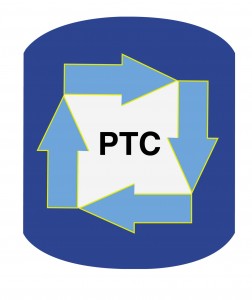We would like to ask our readers for help to understand why quaternary ammonium chloride catalysts are helping this reaction.
In the first step of this reaction, 1,4-cyclohexane dicarboxylic acid is reacted with thionyl chloride to produce the dicarboxylic acid chloride in the presence of both small and large quat chloride salts such as benzyl triethyl ammonium chloride (13 carbon atoms), Aliquat 336 and Adogen 464 (27 carbon atoms). In the second step of this reaction, the acid chloride is reacted with a phenol (4-(6-acryloyloxy-hex-1-yloxy)phenol) to form a mixture of acid monoester and diester. When 10 mole% DMF replaces the 0.5 mole% quat chloride as the “activator,” the conversion is lower.
The inventors state “By using the tetraalkylammonium salt as a reaction catalyst, the target dicarboxylic acid halide can be obtained using less of the catalyst, at a lower reaction temperature, in a shorter time, and with a better yield.” Those are certainly compelling benefits.
The question for which we are requesting reader input is “what is the role of quat chloride?”
Is it possible that the role of quat chloride is to solubilize thionyl chloride in the organic phase (e.g., as Q+ SOCl3-)? That doesn’t seem very plausible. We welcome your comments and speculations.
Please submit your proposed explanation or mechanism to Marc Halpern at PTC Organics. In addition, please let us know if can cite your name and company affiliation if we publish your answer in next month’s PTC Tip of the Month. Thank you.
About Marc Halpern

Dr. Halpern is founder and president of PTC Organics, Inc., the only company dedicated exclusively to developing low-cost high-performance green chemistry processes for the manufacture of organic chemicals using Phase Transfer Catalysis. Dr. Halpern has innovated PTC breakthroughs for pharmaceuticals, agrochemicals, petrochemicals, monomers, polymers, flavors & fragrances, dyes & pigments and solvents. Dr. Halpern has provided PTC services on-site at more than 260 industrial process R&D departments in 37 countries and has helped chemical companies save > $200 million. Dr. Halpern co-authored five books including the best-selling “Phase-Transfer Catalysis: Fundamentals, Applications and Industrial Perspectives” and has presented the 2-day course “Practical Phase-Transfer Catalysis” at 50 locations in the US, Europe and Asia.
Dr. Halpern founded the journal “Industrial Phase-Transfer Catalysis” and “The PTC Tip of the Month” enjoyed by 2,100 qualified subscribers, now beyond 130 issues. In 2014, Dr. Halpern is celebrating his 30th year in the chemical industry, including serving as a process chemist at Dow Chemical, a supervisor of process chemistry at ICI, Director of R&D at Sybron Chemicals and founder and president of PTC Organics Inc. (15 years) and PTC Communications Inc. (20 years). Dr. Halpern also co-founded PTC Interface Inc. in 1989 and PTC Value Recovery Inc. in 1999. His academic breakthroughs include the PTC pKa Guidelines, the q-value for quat accessibility and he has achieved industrial PTC breakthroughs for a dozen strong base reactions as well as esterifications, transesterifications, epoxidations and chloromethylations plus contributed to more than 100 other industrial PTC process development projects.
Dr. Halpern has dedicated his adult life to his family and to phase-transfer catalysis (in that order!).


